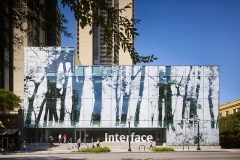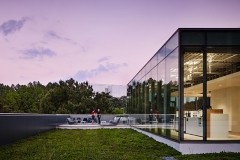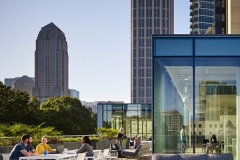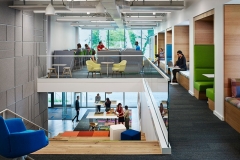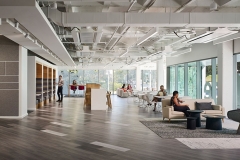Atlanta Georgia: The Interface Head Office is one of our latest on-site water management projects to be completed. This is a WELL certified rainwater collection project for toilet flushing and roof garden irrigation. It is also well on track for LEED Platinum version for certification.
In addition to the rainwater harvesting, the project also includes a treatment skid for City Water reach WELL certified water quality standards to assure the health and well-being of people in the building.
Ecovie worked with engineering firm Integral Group to develop the overall design. Georgia Water Tanks, the local Georgia representative for Ecovie implemented the design and worked with mechanical contractor McKenney’s through installation and start up. Ecovie and Georgia Water Tanks supplied equipment for rainwater collection and city water conditioning working closely with Integral Group on conceptual design and layout while providing and integrating equipment from our key suppliers Intewa, Aqua Treatment Services and QuantumFlo.
The Chattahoochee River Resource
The rainwater harvesting system in the Interface Head Office building alleviates some of the pressure on the Chattahoochee River, including the Lake Lanier Reservoir. This is one of the nation’s smallest watersheds to serve a major metropolitan area and has known water issues.
Serving 5 million people in the Georgia region and 70 percent of Atlanta, this river has become a precious water resource. In order to provide enough clean water for Georgia and Atlanta for now and the future this water resource has to be managed more wisely.
By using a rainwater harvesting system, the Interface building reduces the demand on the Chattahoochee River and provides enough certifiably clean water, sustainably.
This project uses a 15,000 gallon tank to store rainwater that is then treated for use within the building. The tank was assembled on site and installed within the parking area, designed to showcase the system in use. This type of tank was used because of the size restrictions within the building.
The Treatment of Collected Rainwater
The system uses a treatment skid to treat the rainwater harvested from rooftop areas. The treatment is designed to meet local codes for non-potable water uses, in this case for toilet flushing water and for watering the roof gardens.
The treatment skid for the harvested water includes an automatic backwashing sediment filter which is the first step, followed by UV disinfection.
After the harvested rainwater has been being treated it is then passed onto the 500 gallon buffer tank. The treated water then passes to a booster system that pumps it at a rate of 120/gallons per minute to distribute it to the whole building for non potable uses.
The Treatment of City Water
The following process was designed to achieve WELL potable water quality standards for inhabitant well being. Like the treatment skid for the rainwater harvesting, the City Water skid passes 2 sediment filters. It then passes a carbon filter to remove chlorine. Chlorine is a known carcinogen. When chlorine is introduced into water, it kills pathogenic bacteria. But when it’s introduced into the human body, it destroys our beneficial gut bacteria, where an estimated 70% of our immune system operates. To remove the chlorine for this reason, and to make the water tasty, it passes the carbon filter.
The amount of chlorine actually removed during this process is measured on a digital read out display, and this measurement is known as the ORP, Oxidation Reduction Potential. The system is configured and calibrated to ensure that the maximum amount of chlorine is removed, making the drinking water clean and much better tasting.
The Interface Building Design & Architecture
The new headquarters, designed by the Atlanta office of Perkins+Will, was prompted by Interface’s need to centralize its Georgia workforce from three locations to one.
The company selected a circa-1960s office building and embarked with Perkins+Will to create a biophilic workplace environment, i.e. one that would mimic the natural world to benefit human health and productivity.
Biophilic design, says Perkins+Will design principal Bruce McEvoy, “identifies with us at our core. It’s not something that is generational or temporary,” he says. “I think the same things that identify with us through biophilia right now will be just as relevant 25 years from now, 50 years from now.”



